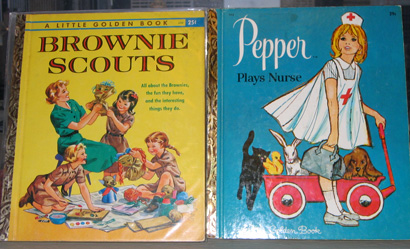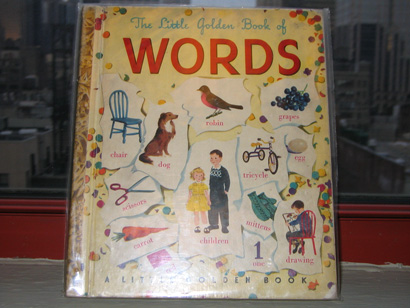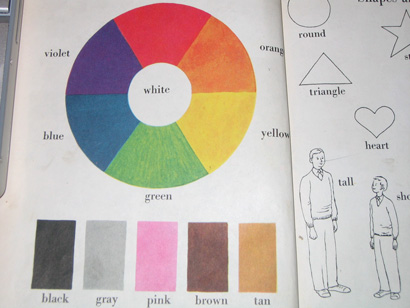Michael Bierut wrote a magnificent piece on Design Observer yesterday about the artist Alton Tobey, and it moved me to tears. It caused this visceral response for maybe a million different reasons, but the lead gene in my reaction was the deep-seeded relationship I have with children’s books and the quest I have been on for decades to recreate the library of my youth.
When I was a kid there were lots of rules in my house. One of the most horrific for me at the time was the (very) limited amount of television I was allowed to watch. As a result, I read. And I read a lot. I read books, magazines, newspapers, encyclopedias and comic books; I even borrowed my mother’s Redbook and Ladies Home Journal, and snuck into my father’s library to read the steamy sections of The Godfather when I was sure that no one would catch me.

My fascination with books began as soon as I could read, and Golden Books were my favorite. As soon as I started grade school, I was introduced to the Weekly Reader and there was nothing, nothing I looked forward to more than that precious moment, every week, when Mrs. Mayer handed out those gorgeous publications. By third grade I was introduced to the Scholastic Book Club, and while my folks might have been stingy with the television privileges, they were quite generous with my book allowance. I ordered as many books as I could afford, and when the boxes came in with my name on them, I’d spend a moment or two gingerly fingering the corrugated brown carton. I’d sit for a minute quietly and imagine what was inside, what the books would be like, and of course: how they would look.
After Scholastic came the series books: Nancy Drew by Carolyn Keene, Trixie Belden by Julie Campbell and my all time favorite: the stories of Ginnie and Geneva by Catherine Woolley.
I treasured those books so much that I read all of the other series’ that Miss Woolley created: the Cathy stories, the Libby “mystery” stories and the David stories. Then I progressed onto the All of a Kind Family series by Sydney Taylor, Madeleine L’Engle’s A Wrinkle in Time and then all of her riveting sequels. And no teenager’s library was complete without Judy Blume’s perennial favorite, Are You There God, It’s Me Margaret and then the nearly x-rated Forever.
A big part of the universe I entered when I read these books was visual. I studied the illustrations and paintings of all of my pristine tomes as intently as I read the words, desperately trying to gain entrance in the two-dimensional galaxy of the author and illustrator in order to make that world my own.
There is a book I remember reading, I couldn’t have been more than 6 or 7; it was about a little girl trying to go to sleep, and the perils and travails that ensued. I fell so deeply in love with this book that I tried to arrange the table by my bed in the exact same way that the lovely heroine of this story (or the illustrator!) crafted her night table—down to where she kept her glass of water. That I can’t remember the name of this book is something that truly saddens me.
The vast and complex characters also mesmerized me: what they looked like, how they dressed and behaved. Though I loved Trixie Belden, it was her best friend Honey that truly intrigued me—beautifully dressed Honey with her good manners and quick wit. And though I admired Ginnie, it was her free-spirited, uninhibited friend Geneva that captivated me. And it was quiet, demure Anna, rather than charasmatic Cathy, who became my compatriot.
The lovely illustrations of both the Ginnie series and the yellow-spined Nancy Drew series became secret pathways into a different reality. A place where, despite danger or mishaps or misdeeds, life was always good, the bad guys were always caught and everyone always lived happily ever after. These worlds were foreign to me and I became a silent and invisible participant in the stories. I joined the characters, lived their challenges and ultimately, I believe I became much richer from the experience.
I don’t know what happened to all of my childhood books. My family moved around a lot when I was growing up, and since many of the books were paperbacks, I guess they didn’t make it from house to house. As a result, for the last several decades I have been scouring used bookstores, libraries, garage sales and flea markets for all of the books I read as a child. I even went to an elementary school book fair one year. I am pretty particular about what I purchase: the Golden Books must have the opulent gold and brown metallic foil, the Nancy Drew books must have the hardcover yellow spine with paintings on the cover (by the way, these paintings were uncredited). The Ginnie books must have the line drawings of Liz Dauber (scroll down the listing to see several front covers) or Iris Beatty Johnson. And the Trixie books must have the cover paintings of Larry Frederick. (again, scroll down) I have been extraordinarily lucky retrieving many of these classics; nevertheless there were two works that eluded me that I was eager to retrieve. Even with the advent of ebay and alibris.com they were proving to be unfindable.
One was a book called Dot for Short, by Frieda Freidman. It was a charming, bittersweet story written in 1947 about an insecure ten year old who can’t wait to grow up. “She envies her two gorgeous sisters (Fluff and Peg) who are tall and slender and know how to talk to boys.” Her family is having financial difficulties, which she feels powerless to improve. Then she sees an ad in a ladies magazine featuring a contest to write a limerick about “why you use Masterpiece Muffin mix.” The prize was $10,000. She, of course, writes a limerick and…well, um…that’s all I am going to tell you! Needless to say the entire scenario of the book converged with my life, my interests, and even my fledgling fascination with…dare I say it?…branding.
All through the 1980’s I not only searched through flea markets and the like for this pesky novel, I also went into every mass market and private bookseller inquiring about the book. Lots of storekeepers were sympathetic and often suggested I order it—optimistically offering that one used book store might come across it if a mass search was initiated. I did that over and over, but to no avail. Then one fine day in 1988, as I was doing my usual perusal in the children’s section of a bookstore…there it was. Reprinted. Fresh and clean and new and…mine. I grabbed it, gave my money to the cashier with shaking hands and read the entire book out on the street, standing up. It was a magnificent, unforgettable experience. I still, to this day, believe that I am single-handedly responsible for Puffin reprinting this book.

The other was a Little Golden Book. I didn’t remember the title, but I could vaguely recall that it had dreamy illustrations on little scraps of paper on the cover, each with a whimsical drawing of an animal or a vegetable—somehow, I remembered a carrot. I thought the book was about art, as the main image I had in my head was a simply, yet profoundly rendered color wheel. I searched for this one as well, and finally, it found its way to me via the 26th Street flea market in New York City. But it wasn’t a book about art, ironically enough, it is called Words. I was lucky though, the version I found was the original edition, the one that I first read.

My library is now nearly complete. Every now and then I remember a new book that I read when I was eight or eleven or sixteen…the memory flutters into my head like a yellow butterfly…and then I am inspired to once again start a search anew. I love this recreation of sorts…knowing that I am simultaneously rebuilding and re-crafting my past and my present and my future. Knowing that, like Proust’s moment with his dear madeleine, these books “ultimately reach the clear surface of my consciousness, this memory, this old, dead moment which the magnetism of an identical moment has traveled so far to importune, to disturb, to raise up out of the depths of my being…But when from a long-distant past nothing subsists, after people are dead, after the things are broken and scattered, taste and smell alone, more fragile but more enduring, more unsubstantial, more persistent, more faithful, remain poised a long time, like souls, remembering, waiting, hoping, amid the ruins of all the rest; and bear unflinchingly, in the tiny and almost impalpable drop of their essence, the vast structure of recollection.”











Thanks, Debbie.
I too was moved by Mr Bierut's article. It sent me searching online for Hardy Boys & Tom Swift cover art. And just now I had a quick look at some Alfred Hitchcock and the Three Investigators covers which I had completely forgotten about owning. I had most of the first 30. They were given to me along with the first sixty-something Hardy Boys books (bright blue spine, painting on the cover) and a bunch of other good books. The only Tom Swift book I ever owned was Tom Swift and His Polar-Ray Dynasphere. (I always thought the space ships parked on the shore in the background were a bit cooler.)
Debbie, dare I mention that I was also a big Trixie Belden fan?
The thing I have wondered about for years is why can't novels for adults have great full-page illustrations at least once a chapter?
On Jan.21.2005 at 09:25 AM